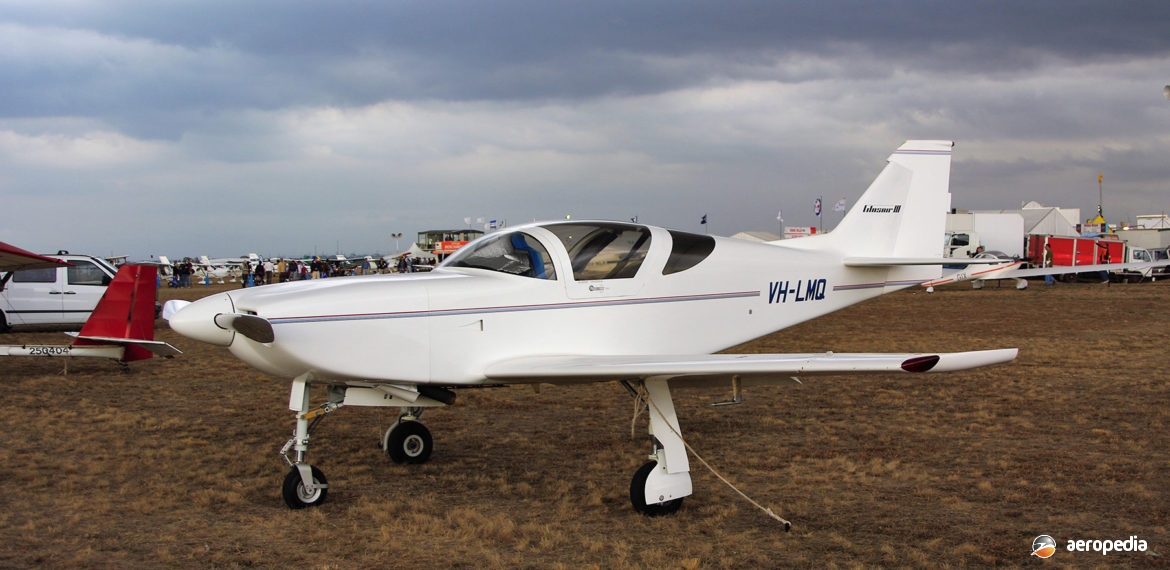Photograph:
Stoddard Hamilton Glasair III VH-LMQ (c/n N185) at Avalon, VIC in March 2009 (David C Eyre)
Country of origin:
United States of America
Description:
Two-seat high-performance touring and sport monoplane
Power Plant:
One 224 kw (300 hp) Lycoming IO-540-K1H5 six-cylinder horizontally-opposed air-cooled engine
Specifications:
- Wingspan: 7.09 m (23 ft 3 in)
- Length: 6.50 m (21 ft 4 in)
- Height: 2.18 m (7 ft 2 in)
- Wing area: 7.55 m² (81.3 sq ft)
- Max speed: 436 km/h (270 mph)
- Cruising speed at 75 % power at 2,438 m (8,000 ft): 415 km/h (258 mph)
- Cruising speed at 65% power at 2,438 m (8,000 ft): 399 km/h (248 mph)
- Stalling speed slotted flaps: 117 km/h (73 mph)
- Stalling speed standard flaps: 129 km/h (80 mph)
- Service ceiling: 7,315 m (24,000 ft)
- Rate of climb: 1,036 m/min (3,400 ft/min)
- Range: 2,092 km (1,300 miles)
- Fuel capacity: 231 litres (51 Imp gals)
- Empty weight: 703 kg (1,550 lb)
- Loaded weight: 1,089 kg (2,400 lb)
History:
The Glasair III was a dual-control aircraft developed for the homebuilt market by Stoddard Hamilton Aircraft of Arlington, Washington, as a more powerful version of the II series. It was an all-composite cantilever monoplane with an enclosed cabin, side-by-side seating, and could be fitted with wing tip tanks in wing extensions of 61 cm (2 ft) which could be quickly removed. A number of variants overseas have been built, as noted below, with turbine engines and examples have attended and raced in their class at the Reno Air Races in Nevada.
The Glasair III series was fitted with engines in the 186 kw (250 hp) to 224 kw (300 hp) range and usually had a retractable tricycle undercarriage. The Glasair III Turbo was fitted with a Lycoming TIO-540 turbocharged engine and retractable tricycle undercarriage; and the Turbine 250/III, a variant of the Glasair III designed in 1994, has been fitted with an Allison 250 turbine that provides a max speed of 531 km/h (330 mph). This model made its debut at Oshkosh and had a lengthened wingspan and ailerons, wet wings holding 326 litres (72 Imp gals) of jet fuel, dorsal and ventral fins, and was painted at one stage in US Air Force markings by the constructors.
A number of examples of the III series have been constructed in Australia and these include: VH-TIJ (c/n 3091); VH-SPG (c/n S130); VH-BRP (c/n 3174); VH-USW (c/n SH-3311); VH-RYK (c/n 3164); VH-TCS (c/n 3228); VH-LMQ (c/n N185); VH-FIQ (c/n 3217); VH-TUR (c/n 3085) and VH-CSH (c/n 3037). A Model G-III was registered as VH-TRM (c/n 3354).

